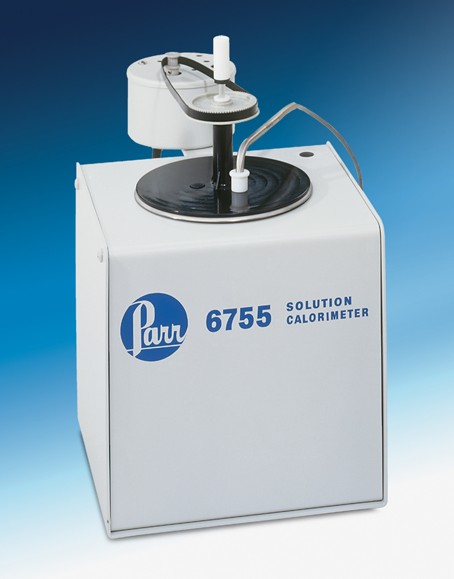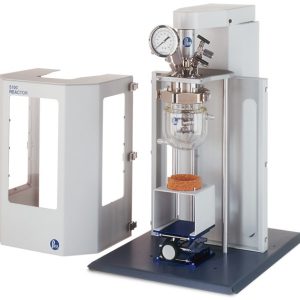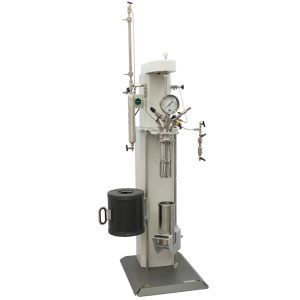תיאור
Utilizing a unique rotating sample cell and a precise microprocessor-based thermometer, the Parr 6755 Solution Calorimeter provides a moderately priced and easily operated instrument for measuring:
• Heats of Reactions
• Heats of Mixing
• Heats of Solution
• Heats of Dilution
• Heats of Wetting
Measurements are made at ambient temperature and at atmospheric pressure in either liquid-liquid or liquid-solid systems covering energy changes ranging from 2 to 1000 calories. All operations are straightforward and simple, using a menu driven touch screen display. Precise temperature measurements are shown on a bright, color, display and outputs are provided for a printer, computer or Ethernet style network (LAN) connection. Real-time plotting on the LCD screen replaces the analog output of the previous model 1455 and eliminates the need for a strip chart recorder.
Many Different Reactions
Any liquid-liquid or liquid-solid chemical reaction in which heat is evolved or absorbed within a temperature range from 10° to 50°C can be studied in the 6755 Calorimeter.
Heats of Reaction, either endothermic or exothermic, can be determined in many different systems, ranging from simple acid-based reactions to more complicated redox, chelation, hydrolysis, hydrolysis and other reactions. The calorimeter is particularly effective for assays of weak acid and weak bases that do not respond readily to other detection methods. It can also be used for rapid specific ion determinations by thermochemical methods, as best illustrated by determination of sulfur using barium chloride to precipitate barium sulfate from a sulfate solution.
The heat of solution produced when a solid dissolves in a liquid can be measured easily. Similarly, the calorimeter can be used to measure the heat of dilution produced by diluting a solution with solvent or with a solution of a lower concentration. It will also measure the heat of mixing, produced when two liquids are combined.
The heat of wetting as measured with this calorimeter serves not only as a thermochemical measurement, but also as a rapid method for determining the surface area of a powdered solid, since the heat released when a power is treated with a wetting agent will be proportional to the exposure surface area.
A Well Insulated Reaction Chamber
All reactions in the 6755 Calorimeter are conducted in a fully silvered glass Dewar, 48 mm inside diameter x 103 mm deep. The Dewar is supported within a stainless steel air can from which it is easily removed for filling or cleaning. A block of plastic thermal insulating foam surrounds the air can, with the entire assembly mounted in a rugged aluminum case.
A Unique, Rotating Sample Cell
A closed glass bell with a detachable bottom holds a solid or liquid sample in the Dewar and also serves as the stirrer for the calorimeter system. The bottom of the cell is closed with a Teflon® dish that fits snugly into the bell without requiring a gasket or sealing ring. Solid samples (up to 2 grams) can be weighed directly into this dish before it is attached to the bell. Liquid samples (up to 20 mL) can be added to the closed cell from a pipet inserted through the top stem. To start the reaction, a glass push rod is inserted from the top of the calorimeter through the stirring shaft and into a socket in the sample dish. When this rod is pushed downward, the dish slides out of the cell and remains attached to the rod, held at a fixed distance above the bottom of the reaction vessel. In this position the rod and dish rotate with the cell, slinging the reactants into the solution and serving as an additional impeller in the stirring system.
Heat leak from the cell to the non-wetted parts of the system is held to a minimum by a low conductivity, thin walled glass stem on the sample cell and a plastic coupling which fastens the cell to the stirring shaft. The cell is easy to load, easy to clean and, if broken, it can be replaced at minimum expense since the sample dish and other parts are interchangeable. The dish itself is made of Teflon® reinforced with glass fiber for excellent resistance to most chemical agents and good dimensional stability.
The Stirrer Drive
The stirring mechanism consists of an externally mounted electric motor with a drive belt that turns the stirring shaft at a constant speed (approx. 450 rpm) with no slippage and very little bearing friction. The hollow drive shaft terminates at the underside of the calorimeter cover where it joins the low conductivity coupling on the end of the sample cell.
Easy to Operate
The operation of the 6755 Calorimeter is classically simple. At the start of a test one liquid is held in the glass Dewar while the other reactant, either solid or liquid, is held in the sealed rotating cell which is immersed in the first liquid. The system comes to equilibrium quickly with only a slight temperature drift from the heat of stirring and from any heat leak into or out of the calorimeter. After recording the initial drift and without interrupting the rotation of the sample cell, the operator starts the reaction by depressing the push rods that drop the content of the cell into surrounding liquid. The reaction then proceeds to completion under the vigorous stirring action of the rotating cell.
Precision Thermometry
Temperature in the Dewar are measured with a Parr 6772 Calorimetric Thermometer that is included with the 6755 Calorimeter. Readings are taken with a thermistor sealed in a stainless steel probe. Although the thermometry section has a working range from 10° to 50°C, best calorimetric results are obtained when working within +/- 5°C of a room temperature, since the system depends on a glass Dewar for controlling the heat leak.
The thermometer in the calorimeter can also be used for general purpose, high precision temperature measurement in other applications, using a thermistor probe in a stainless steel sheath (1168E2). It can be used for measurements in the 10° to 50°C range. All of the features including the touch screen display, real-time plotting, data logging memory and communications capability provided for in the 6755 Calorimeter are available when using the thermometer portion of the calorimeter as a stand- alone instrument for other applications. Also included in the precision thermometer is a built-in ignition unit for those who want to combine its functionality with combustion calorimetry, such as the Parr 6725 semi micro calorimeter.
Data Collection and Reporting
The 6755 Calorimeter incorporates a data logging routine that samples and stores the calorimetric temperature and other key ancillary measurements at a user specified rate. This information can be transferred to a printer via a USB port or to a computer via an Ethernet connection using standard network protocols. The software built into the calorimeter can provide temperature rise data that is corrected for heat leaks and the heat of stirring in the system or, it can provide uncorrected temperature readings for manual, computer or graphical analysis. A Parr 1758 Printer is offered for users who wish to take full advantage of the onboard reporting and printing capabilities of the calorimeter. This is a compact, dot matrix printer, set up for 40 character/line reports. It is housed in a separate case 5.5 inches wide, 9 inches deep and 7 inches high. A standard USB port with full configuration software is provided for the printer connection. The printer port can be configured to work with other printers using USB communication that the user may choose.
Precision
The precision obtainable with the 6755 Solution Calorimeter will be a function of the amount of heat liberated by the reactants and the temperature at which the test is conducted. The best precision will be obtained when working with reactions that release between 200 and 600 calories, producing a temperature rise of 1.5° to 5°C at or near room temperature. Under these conditions a standard deviation of less than 0.4% of the determined value can be obtained in repetitive tests. If the total heat release produces a rise of less than 0.5° or more than 6°C, or if the test is conducted at higher working temperatures with significant heat leak, the relative standard deviation may increase to 1.0% of the determined value.
________________________________________
Operating Specifications
Operating Specifications for the 6755 Solution Calorimeter
Description Specification
Working temperature range 10° to 50°C
Temperature sensitivity 0.0002°C
Energy measurement range 2 to 1000 calories
Detectability limit 0.1 calorie
Energy equivalent 100-145 calories/°C
Maximum volume, solute 20 mL
Required volume, solvent 90 to 120 mL
________________________________________
Standardization
Three different procedures are available for standardizing the calorimeter:
• Chemical standardization is readily accomplished using a precise, reproducible exothermic reaction of tris(hydroxymethyl) aminomethane with 0.1 N HCL in an NIST procedure that is described in the instructions furnished with the instrument. A 100-gram bottle of ‘tris’ is furnished with the calorimeter for this purpose. Additional supplies can be obtained from Parr, or the basic reference material may be purchased from the National Institute of Standards and Technology (formerly the National Bureau of Standards) identified as NIST Standard Reference Material (SRM) No. 724.
• Comparison standardization involves the use of known samples supplied by the user. By selecting samples whose enthalpy changes are known and whose thermochemical behavior is similar to the unknown material, the calorimeter can be standardized by simply running duplicate tests with known and unknown materials.
• Electrical standardization requires an electric heating probe, a uniform power supply, a high precision voltmeter and a precise interval timer. Except for the A274C probe this equipment is not sold by Parr, but can be obtained from commercial sources.
Specifications:
• 0.4% Precision Class (1.5 – 5.0 °C rise at or near room temperature)
• 10 – 50 °C working Temperature Range
• 0.0001 °C Temperature Sensitivity
• 2 – 1000 Calories Energy Measurement Range
• 0.1 Calorie Detection Limit
• 100 -145 Calories/°C Energy Equivalent
• 20 mL Maximum Volume, Solute
• 90 – 120 mL Required Volume, Solvent
• USB port for Printer and Balance Communication
• SD Memory card slots for easy transfer of data and log files
• TCP/IP via Ethernet Network Connection
• 6755: Dimensions (in): 9w x 13d x 13h
• 6755: Dimensions (cm): 22w x 33d x 33h






